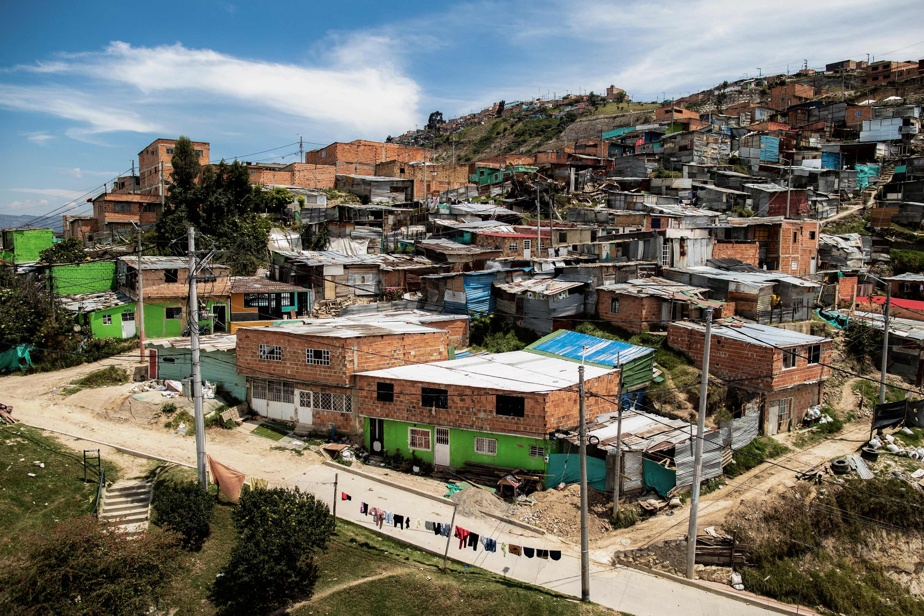(Bogota) The cable car crosses Ciudad Bolivar, a poor and isolated neighborhood in the south of Bogota. Every Sunday, its cabins exchange their stream of workers who go daily to the construction sites in the center of the capital, for a few groups of daring tourists.
After flying over the sprawling neighborhood for about ten minutes, where mountainside shantytowns and brightly colored houses alternate, the TransMiCable cabins drop visitors off at El Paraiso, where a small tourist center welcomes them.
It was in 2016 that May Rojas and Luisa Sabogal, two Colombian artists, chose this district offering a panoramic view of Bogota to launch their artistic-tourist project. At that time, Ciudad Bolivar’s reputation was nothing but mud, misery and violence.

PHOTO ALEJANDRO MARTINEZ, AGENCE FRANCE-PRESSE
Guide May Rojas (center)
“We wanted to help put an end to the stigmatization of Ciudad Bolivar, through art as a vector of social transformation in the territory,” says Luisa Sabogal, 24, who grew up in the neighborhood.
The two entrepreneurs bring in dozens of “street artists”, local and international, to paint “La Calle del color” (the street of color), a set of murals telling local history and culture, between smiling faces and animals emblematic of Colombia’s rich biodiversity.
New “Communa 13”?
Since then, several businesses, tourist agencies and even a five-story museum, the “Museum of the Self-Constructed City” (MCA, a metaphor in reference to the tin slums), have opened.
But the district continues to suffer from a pejorative image which prevents it from popularizing its tourist offering, particularly among the inhabitants of Bogota.
More than half of Ciudad Bolivar’s 660,000 residents are in poverty, living on an income of less than 536,000 pesos per month (about $190).
It is also the neighborhood with the most homicides (188) in 2023, according to data from the town hall security secretariat (SIEDCO).
Before coming, “I was worried about taking photos of the graffiti, I wondered if it was safe to take out my phone,” confesses Tomas Velasquez during a guided tour of the neighborhood. An engineer, he lives in Chapinero, a bourgeois-bohemian neighborhood in the north of the city.
Despite some fears, an average of 400 visitors come to Ciudad Bolivar each month, according to the local municipality. An embryonic tourism, but enough to rejoice the town hall of Bogota, which is already seeing the positive impacts.

PHOTO ALEJANDRO MARTINEZ, AGENCE FRANCE-PRESSE
“The street of graffiti was once called “the path of crime”. It was a street where people killed, where people murdered, where people stole… This year, we have not had a single crime recorded in the area,” says Andrés Santamaria, director of the Institute of Tourism (IDT) of Bogota.
The new town hall, elected in October 2023, wants to make community tourism one of the spearheads of its development policy, with “the objective that Ciudad Bolivar becomes one of the main tourism sites in the city of Bogota”, modeled on the now famous Comuna 13 of Medellín.
This popular neighborhood, under the yoke of violence during the years of rule of Pablo Escobar’s cartel, has since been pacified, has transformed into a destination of choice for tourists passing through Colombia’s second city.
“Poverty remains”
For Ciudad Bolivar, the town hall says it is currently supporting the training of 40 new official local guides and the opening of a visitors center near the cable car arrival.

PHOTO ALEJANDRO MARTINEZ, AGENCE FRANCE-PRESSE
Attracted by the economic transformation of the neighborhood, Maria Sandoval opened a small shop four months ago selling tamales – traditional papillote of indigenous origin.
The trader, whose shop is located opposite the cable car landing stage, welcomes the arrival of tourists, who represent “around 50%” of her turnover.
But a few meters further, outside the marked corridor where visitors wander, the positive repercussions are still difficult to see.
On the steps of their modest home, Nadia Rojas and her daughter observe, skeptically, the visitors passing in the street perpendicular to theirs.
“It’s positive because tourism creates jobs […]. But I always see the same young man giving tours to all the tourists. Everything is concentrated in the hands of a few,” notes Nadia. “The facades are painted, but poverty remains,” she says.
